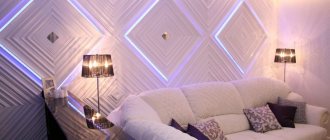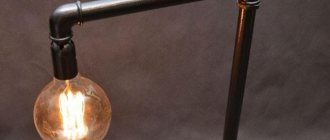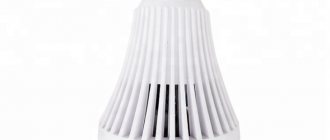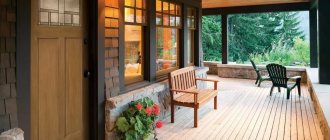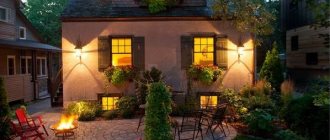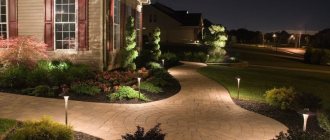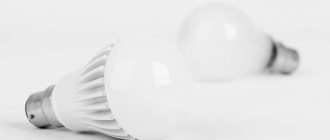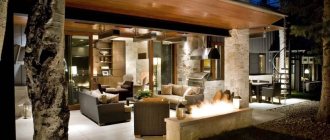No. 1. Main types of ceiling lamps
The main task of artificial lighting is clear even to a child. However, it is not enough for a lamp to simply provide light - it is important that this light helps create a comfortable environment. It should not hit the eyes, distort the colors of objects or make it difficult to perceive space. Some areas require bright lighting to organize, while relaxation areas require soft, diffused light. Obviously, one lamp cannot cope with such different tasks, so humanity has come up with different designs of lighting devices.
Ceiling lamps can be divided into the following types:
- hanging. The most striking example is the chandelier that is familiar to all of us. Such lamps are attached to the main ceiling with a chain, spring or rod, and are located at some distance from it. By size pendant lights can vary greatly: luxurious crystal chandeliers, for example, will fit well into large, tall rooms. For rooms with low ceilings, pendant lights are not the best choice, but compact models can also be found. Chandeliers can be created as diffused general light and directional - it all depends on the design of the lampshade. Often a group of several pendant lamps is installed above the dining table; the height of the suspension in some models can be adjusted. The number of lamps in such products is from 1 to dozens;
- invoices. This includes plate chandeliers, they are often called lampshades. Such products are attached to the ceiling and have a flat, compact design, making them well suited for low rooms. In terms of variety of shapes, sizes, materials and other design features, surface-mounted lamps are not inferior to pendant lamps;
- built-in. They can be mounted into a suspended or suspended ceiling structure, allow you to create an interesting lighting system, take up minimal space, are installed flush with the ceiling, can be rotary. With the growing popularity of slatted, plasterboard ceilings and other suspended structures, such lamps are used more and more often. The concepts of recessed and spotlights are often confused. Spot lighting is a system of single compact luminaires, they can be built into the ceiling or overhead and protrude slightly above its surface;
- spots or soffits were created when the advantages of spot lighting and overhead lamps were combined in one design. The spots provide narrowly focused light, have a rotating design, and are installed several times on one guide. An excellent option if you want to enjoy the benefits of spot lighting, but for some reason it is impossible to install a suspended or suspended ceiling. In addition, you need to make a minimum of effort - and the direction of the light can be changed, creating the necessary atmosphere in the room;
- needs to be highlighted separately flexible luminaires. These are LED strips; neon tubes and duralight cords are less commonly used. They take on the role of decorative lighting and are located along the contour of the ceiling and in the ceiling plinth.
The choice of the type of ceiling lamp depends on what kind of lighting needs to be created, how high the ceilings are in the room, and what technology they are made of.
LED Ceiling Light for Home
Types of LED ceiling lights
Invoices
These types of devices are installed on dowels or screws. Surface-mounted lamps are equipped with housings with sockets, electrical wires, and also elements for regulation. The body has a dissipative grille or glass. The main advantage of overhead devices is ease of installation, but there is a rather important condition. It lies in the need for a static, reliable base for mounting the lighting device. After the installation process, the clamps are covered with a lampshade, and therefore do not spoil the appearance of the lighting fixture.
Hanging
Suspended-type devices for a private home are quite often used as a local light source. They are compact and have a beautiful, stylish appearance. The base material for manufacturing the body of the suspension device is polymers. Lenses used are polycarbonate or glass. A special feature of the pendant devices was the method of fastening. The installation is carried out on suspensions, and the mounting height of the lamp is adjusted and controlled when the length of the cable changes.
Mortise
Recessed spotlights are installed in suspended types of structures. We are talking about a wide variety of ceiling devices, including slatted, plasterboard or panel. The lamps are cut directly into the sheathing layer and secured with tendrils on springs. The clamps expand the structure and thus hold the lighting fixture. Recessed LED lamps are also used when organizing lighting in rooms with suspended ceilings. But in this case, the device is installed on a previously installed ceiling structure. Due to this approach, it is possible to avoid sagging of the canvas. When choosing a mortise-type device, it is recommended to take into account many circumstances:
- For lighting, it is best to use low-power diodes, i.e. 12 or 24 V. Such lamps are offered without electrical power converters and have a long service life.
- The power supply must be mounted outside the structure on the ceiling, and the whole point is that most often it is a breakdown of the power supply that is the reason that the lamp does not light. As a result, it is worth ensuring unobstructed access to the power supply so that its repair work does not involve dismantling the suspension or even tension fabric.
Please note that it is not recommended to install LEDs in damp areas. If you have no other choice, then you will have to install protective specialized shades on the lamps. The level of security can be easily determined by the markings located on the lampshade (letter code “IP”, followed by 2 digits). On a structure that is resistant to moisture, the second digit must be at least 4.
Panels
LED ceiling panel lights are usually used to illuminate office spaces. Interestingly, such devices can even be used to illuminate large areas in country houses. One lamp can produce 5,500 lumens, which is equal to 500 watts on an incandescent lamp. The device's electrical energy consumption is low (75 W). Based on the shape, panels with light diodes can be divided into those made in the form of a circle, square, oval or rectangle. Asymmetrical lamps are also available. There are many sizes of lamps, but for a country house it is best to choose lamps with a size of 0.6 * 1.2 or 0.6 * 0.6 meters. The thing is that such dimensions allow LED lamps to fit into the groove of the ceiling structure without any obstacles.
Soffits
Lamps of this type are used to organize a highly concentrated light flux, which allows maximum high-quality illumination of small areas. Fixtures equipped with spotlights are usually equipped with 2-3 lamps, the total power of which is up to 9 W. The soffit is fixed to the main ceiling or ceiling surface. In the case of suspended ceilings, you will need to create an additional base to mount the soffit.
Ribbons
LED strip lights are flexible designs with a huge number of small diodes. Special power supplies are used for tapes. The tape is not suitable for organizing full lighting. Its main purpose is to illuminate the ceiling surface. It is quite important to install LED strips correctly. The main rule is that the device should be invisible after installation. Below are tips for installing tapes:
- The number of light diodes per meter of tape differs significantly depending on the type of device and the manufacturer. The diode density ranges from 30-230 units per meter of tape.
- The standard size of the tape is 5 meters, but if desired, you can extend the tape if another device is connected to the power supply. Please note that the strips should be connected exclusively in parallel.
- The tape can be cut only along special notches that are along the total length of the lighting device.
- Under no circumstances should the tape be bent along a radius that is less than 2 cm.
- The power supply should be placed outside the ceiling structure.
Now let's look at all the pros and cons.
Advantages and disadvantages
The advantages of LED lighting devices include the following parameters:
- Economical consumption of electrical energy. LED can be called the most economical lighting technology. Only 22% is converted into light energy. This figure is truly impressive if you take into account the fact that in the case of incandescent lamps the conversion percentage barely reaches 2.6.
- Modern diodes produce light that is 8-10 times greater than that of accumulation lamps. For example, an 8-watt LED lamp fully replaces and even surpasses a 60-watt storage lamp.
- Slight heat generation. Light diodes practically do not release thermal energy into the environment, since most of it is distributed to the device’s power converters. There are quite a few electrical appliances that should never be placed close to heat sources. It is permissible to install any devices near diode lamps without the risk of overheating.
- Small size. Recessed LED ceiling lights are usually no more than 1 cm in thickness. Mortise devices are also small (from 2 to 2.6 cm in thickness).
- There is no inertia. In other words, the lamp power will be maximum from the very beginning, rather than increasing gradually (as is the case with accumulation lamps).
- No flicker. Due to this quality, lighting will not have a negative impact on human vision.
- There are no harmful emissions when working with lamps, and there is also safe disposal at the end of their service life.
- Concentration of light flux. Other types of lamps diffuse the flow of light, causing the lighting to become less directional. Diodes direct light onto the hemisphere in the direction in which the lighting fixture is turned.
- Large on and off cycle. Unlike most other light sources, turning it on and off does not affect the lifespan of LED devices.
There were some shortcomings. The first disadvantage was the high cost, because LED devices are the most expensive lighting method. There are relatively inexpensive Chinese products on the appliance market, but the quality of the products is not the most encouraging. Additionally, light diodes are quite sensitive to high temperatures (i.e. overheating). They should not be used at temperatures exceeding +50 degrees. Because of this, powerful devices are equipped with heat sinks, which leads us to the first disadvantage - the product becomes more expensive.
No. 2. Types of lamps by light distribution
Depending on the design and material of the lamp, it can produce light in different directions. Based on light distribution, luminaires can be divided into the following types:
- direct distribution. This is a directional luminous flux to illuminate a specific area, for example, a desk or work surface in the kitchen. This light is provided by spotlights and spots;
- mostly direct. In this case, the light falls on the illuminated surface, and only a small part of it is scattered upward, allowing you to create a pleasant, uniform illumination in the rest of the room. Such light is provided by lamps with lampshades made of transparent material;
- predominantly diffuse lighting is created by directing the flow of light into the ceiling and reflecting the rays from it. The design of many chandeliers ensures the creation of just such light;
- diffuse lighting is obtained when light is directed onto the ceiling and walls. The rays reflected from the surfaces create a pleasant and calm lighting.
Naturally, it is impossible to say which type of light distribution is better - the choice of a specific type depends on the tasks set and the need to create lighting of a certain nature.
According to functionality, lighting can be:
- main . It is necessary to navigate in space and comfortably engage in activities that do not require strong visual concentration;
- working, or zonal . Used to illuminate places where brighter lighting is needed (for reading, working, sewing, etc.);
- decorative _ Used to illuminate paintings, niches, arches, plinths or other interior elements. Can be used to create a certain atmosphere.
One room may need different types of light, so in modern homes it is necessary to use multi-level lighting . For this purpose, ceiling lamps of various types will be useful, which will be complemented by LED strips, floor lamps, table lamps, sconces and lighting in cabinets.
Advantages and disadvantages
Let's start with this, because LEDs were specially designed as an economical alternative to all other types. Therefore, the first criterion is efficiency. In fact, LED light sources are by far the most economical.
- Firstly, with their help, 22% of electricity is converted into light. Many may think that this figure is not very high. But compare it at least with incandescent lamps, where the percentage barely reaches 2.6. And this is almost ten times more economical.
- Secondly, the same applies to the light ceiling. LEDs burn 8-10 times brighter than conventional incandescent lamps. For example, an 8-watt lamp (this is an LED) can replace a 60-watt incandescent lamp.
The second advantage is low heat generation. The lamps themselves practically do not emit heat; the main emission of heat is distributed to the lamp's power converters. But why is this indicator important? There are a large number of household appliances that should not be installed near heat sources. You can place whatever you want under LED lamps without compromising the quality of the devices.
LEDs are an economical alternative to other types of lamps
The third plus is the direction of the light ceiling. The thing is that the main types of lamps scatter light almost in a circle, which affects the reduction in the flow power as a whole. LEDs direct the flow onto the hemisphere in the direction in which the lamp is turned. That is, the flow has a certain direction with greater power, which affects the brightness of the lighting.
The fourth advantage is the complete absence of harmful substances that can be released during operation of the lamp or its destruction. Fifth is the absence of flicker, which negatively affects human vision. The sixth is the absence of inertia. What does it mean? When the lamp (ceiling LED) is turned on, its brightness immediately becomes maximum. No gradual increase in power.
The seventh advantage is its small overall dimensions. For example, an LED lamp for recessed ceilings is only 1 cm thick. The Fusion brand offers recessed lamps with a thickness of 26 mm.
Overhead lamps for the ceiling
And the last advantage is the huge on/off cycle. The most important thing is that this indicator is in no way related to the life of the lamps. That is, you can practically turn it on and off all the time throughout the entire service period, and at the same time the lamps themselves will not fail. The same cannot be said about other types of light sources.
No. 3. Type of lamps for ceiling light
Although choosing the type of light bulb is a completely different topic, we cannot ignore it, since the organization of lighting and the nuances of choosing the design of a ceiling lamp depend to some extent on what kind of lamp will be used. Today there are several options:
- Incandescent lamps are inexpensive, have a pleasant warm light, but also do not last long, are uneconomical, have low efficiency and high heat transfer, and therefore their scope of use is limited. If we are talking about choosing a ceiling lamp for a stretch film ceiling, then it is better not to use incandescent lamps - they can damage the film with their heat;
- Halogen lamps are similar to incandescent lamps, but the bulb is filled with halogens, which allows them to slightly extend their service life. With dimmers, such lamps can last up to 8 thousand hours, but they still cannot be called economical. In addition, their heat transfer is also high;
- fluorescent lamps are 5 times more economical than incandescent lamps and 5-20 times more durable. The surface of such lamps does not get very hot; the light temperature can be almost any. The main disadvantage is the content of mercury vapor in the flask, so they must be handled with care during operation. Problems are also associated with the disposal of such products. Other disadvantages include sensitivity to voltage changes, flickering and the need for some time for the lamp to start shining at maximum;
- LED bulbs - the most modern to date. They are 6-10 times more economical than incandescent lamps and 2-3 times more economical than fluorescent lamps, durable (shine up to 20-50 thousand hours), safe, do not require warm-up time, are not sensitive to voltage surges, are durable and do not heat up. These are the most expensive lamps of all, but they are guaranteed for a couple of years, and they last for years. For rooms where the lighting is turned on every day for several hours, this is the best option.
No. 4. Features of the ceiling and type of lamp
When going to the store to buy a lamp, do not forget to take into account the features of the ceiling structure:
- low ceilings and massive chandeliers are a completely incompatible pair. Comfortable life can be ensured if the distance from the floor to the bottom edge of the lamp is 2-2.3 m. In Khrushchev-era buildings, where the ceiling, according to the project, is 2.3 m, it is better to use surface-mounted lamps, spots and built-in lighting. With a ceiling height of more than 3 m, you can also look in the direction of beautiful hanging chandeliers, but do not forget to balance the size of the lamp with the area of the room - a small chandelier in a large room will look just as ridiculous as an overly large lamp in a small room;
- For concrete and wooden ceilings, the mortise type of lamps is not suitable. You will have to be content with different types of chandeliers, and if the ceiling height is small, then overhead lamps and spots will come to the rescue;
- All types of lamps are suitable for suspended ceilings It is only important when installing the structure to leave the required size of the technological gap between the main ceiling and the suspended ceiling, and to correctly cut the holes for future lighting items. Suspended ceilings give maximum scope for imagination, allow you to organize a complex lighting scheme and hide all the wires;
- stretch ceiling also allow you to create complex multi-level lighting. If you choose a film ceiling, then you need to take into account that it is afraid of strong heating, so incandescent lamps for built-in and surface-mounted lamps are taboo. They can be used at a distance of 30-40 cm from the ceiling surface, the maximum power of incandescent lamps is 60 W, halogen lamps are 30 W. It is advisable that such lamps are not directed towards the ceiling. For suspended ceilings, energy-saving lamps (LED and fluorescent) that emit a minimum of heat are best suited.
Lighting standards for premises for various purposes
The illumination level is indicated in lux (Lx). This is a luminous flux of 1 lumen (Lm) per 1 m² of room. Lumen is a parameter perceived by the human eye that varies depending on the illuminated area. If you direct 100 Lux per 1 m², the illumination will be 100 Lux. If the same rays are projected onto 10 m², the illumination indicator will be only 10 Lux.
Standards for refreshing residential premises.
Depending on the purpose of the rooms and the work being carried out, there are different requirements for the level of illumination. There are SNiP standards relating to different types of premises. According to them, the required illumination is (in Lux):
- for the corridor, bathroom, toilet, pantry - 50;
- in the wardrobe - 75;
- for the stairs of a multi-storey building, sauna - 100;
- in the kitchen, bedroom, living room - 150;
- for children's rooms - 200;
- in libraries, classrooms, office with PC - 300;
- in rooms for drawing work, assembly of small parts - 500.
When choosing the lux of an LED lamp, do not forget that this is the illumination indicator for 1 m². If you screw in a 150 lux light bulb in a 10 m² bedroom, this will not be enough: 1500 lux is required.
SNiP standards are designed for rooms with a standard ceiling height of 2.7 m.
The further the light bulbs are located from the object, the worse it is illuminated. Therefore, an correction factor is applied for ceilings with a height of more than 2.7 m. Depending on the level of ceiling rise, it is:
- up to 3 m - 1.2;
- within 3.0-3.5 m - 1.5;
- from 3.5 m to 4.5 m - 2.
There is a direct relationship: the need for light increases with increasing ceiling height.
No. 5. How much light will the lamp provide?
To create a sufficient level of lighting in a room, it is necessary to select the correct design of lamps, their number and lamps of the required power. For each type of room, the lighting level requirements are different :
- for bedrooms and other rooms with dim light, it is necessary to provide 10-12 W of lamp power per square meter;
- for children's rooms , bathrooms and rooms with an average level of lighting, the norm is 15-18 W/m2;
- for kitchens and other rooms where the light should be bright - 20 W/m2.
Let us immediately note that all the standards presented below relate to general (not work and decorative) lighting. The parameters are given for incandescent lamps. When using other types of lamps, power level conversion tables can be used.
For example, for a kitchen with an area of 10 m2 it is necessary to provide 200 W of lighting power. These are 5 incandescent lamps of 40 W, 10 incandescent lamps of 20 W or 2 of 100 W - it all depends on the design of the lamps and their quantity. If LED lamps are used, you will need 5 lamps of 4-5 W or 3 lamps of 10 W.
Much, of course, depends on the nuances of the design. To prevent glare, choose opaque lamps in which the shade completely covers the lamp.
As for spot lighting , one lamp illuminates an area of about 2 m2. If such light is to be used as the main light and not as an additional one, then a lot of lamps will be needed - they are installed in increments of 1-1.2 m, the distance to the wall is 0.6-0.7 m.
Is the type of lighting and surface characteristics important?
The design of premises involves 3 types of lighting: accented, functional, general. Each of them affects illumination to a greater or lesser extent. Knowing the characteristics of the species, the required indicator is calculated.
Accent lighting is used in the interior to highlight objects and create the desired atmosphere. Various lighting effects and shades are used, obtained from economical sources: LED strips, small lamps. There are no special requirements for the level of illumination.
Functional lighting is used for additional illumination of the workplace in the kitchen, workshop, office, near the mirror, etc. Designers use it to zone rooms.
The purpose of general lighting is to provide the amount of light needed for a room. Sources are placed on the ceiling, walls, using floor lamps, etc. The type of lamps does not matter. General lighting is used when calculating the required level, without taking into account accented lighting; sometimes local lighting is taken into account.
Sometimes, after all the calculations, it turns out that the illumination is insufficient. This happens when the reflectivity of surfaces is not taken into account. If the walls or floor of the room are dark, the ceiling is dull, the illumination decreases. For example, the lighting above the desk is bright and sufficient for work. For reading a book on the sofa, the light intensity is not enough, because the rays are poorly reflected from dark walls.
Formula for calculating the reflection coefficient.
There is a reflectance coefficient (RC), which depends on the color of the surface:
- white walls and ceiling reflect 70% of light;
- light - 50%;
- gray - 30%;
- dark - 10%.
Black surfaces do not reflect anything, absorbing rays. Determine illumination taking into account reflection using tables. There is a simplified formula according to which the average reflective coefficient is equal to the sum of the RC of the walls, ceiling, floor, divided by 3. This coefficient is used in calculations.
No. 6. Style and material of execution
It is impossible to describe the entire range of lamps presented in stores - literally every season designers surprise us with new functional finds. This means that each of us gets a chance to arrange the room exactly the way we want. On the other hand, the interior must be harmonious, so the lamp must fully correspond to the chosen style of the room.
Ceiling lamps can be made from the following materials:
- metal allows you to create both classic forged chandeliers and ultra-modern spotlights that will become an integral element of the interior in the high-tech or minimalist style . The design can be made of different metals and alloys, and have a shade from almost black to chrome. Metal is a plastic material that allows you to create a lamp of any shape. Simple recessed metal lamps will fit into modern interiors , unusual chrome chandeliers and spotlights - into the Art Nouveau , fancy forged - into the classic interior. There are options for loft and even Provence;
- wooden lamps – these are mainly chandeliers and overhead shades. They are varied in size and shape and will decorate your interior ethnic style (Japanese, country). It is better to use such lamps in dry rooms with stable temperature conditions;
- glass – a plastic material that allows you to create both exquisite pendant chandeliers and compact overhead lamps. Products may differ radically in shape, degree of transparency and color, but the general advantages include versatility, spectacular appearance and resistance to various kinds of negative influences. To maintain the lamp in proper condition, you will only need to periodically wipe it from dust;
- textile As a rule, plate chandeliers are made; there are also pendant chandeliers with fabric shades. Textiles allow you to turn any design idea into reality and effectively diffuse light. Despite the fact that durable fabrics with special impregnations are used to make such lamps, they have no place in kitchens. Textile lamp is a good option for an interior in style classic, provence, country, boho – it all depends on the type of fabric and shape;
- plastic ceiling lights – these are pendant chandeliers and plate chandeliers. Sometimes very unusual products are created from plastic; they are not afraid of moisture and are easy to care for, but it is better not to use ordinary incandescent lamps with them, which are characterized by high heat transfer. A plastic lamp is a good option for an interior in style modern.
There are also paper lamps, but this is an option for everyone. If you don’t find a suitable design, you can always create a lampshade yourself.
As for the design of spotlights , it does not differ in particular variety and sophistication, because the very essence of such designs does not imply emphasizing them. Spotlights are necessary to create bright local lighting, and for beauty you need to take a chandelier.
The lamp must match the style of the room not only in terms of material, but also in form . For example, modernism presupposes the presence of smooth curved lines, which can also be used in a lamp. Classic interiors include chic crystal or wrought iron chandeliers. For high-tech, both modest spotlights and futuristic chandeliers made of metal and glass are suitable.

